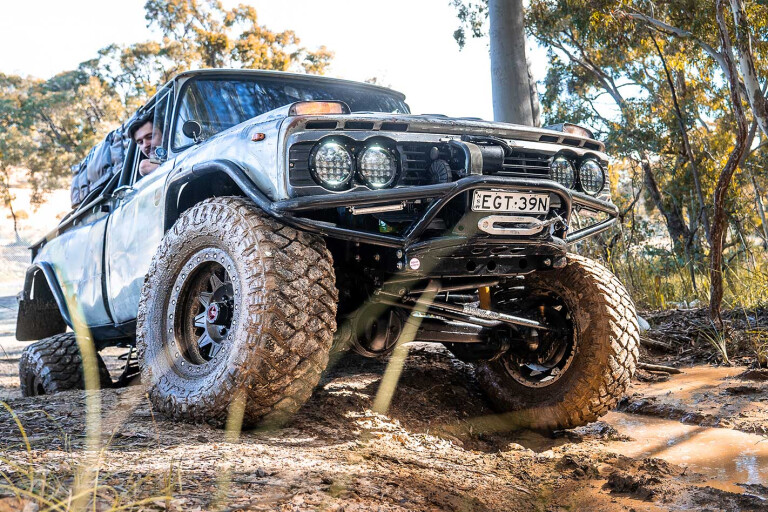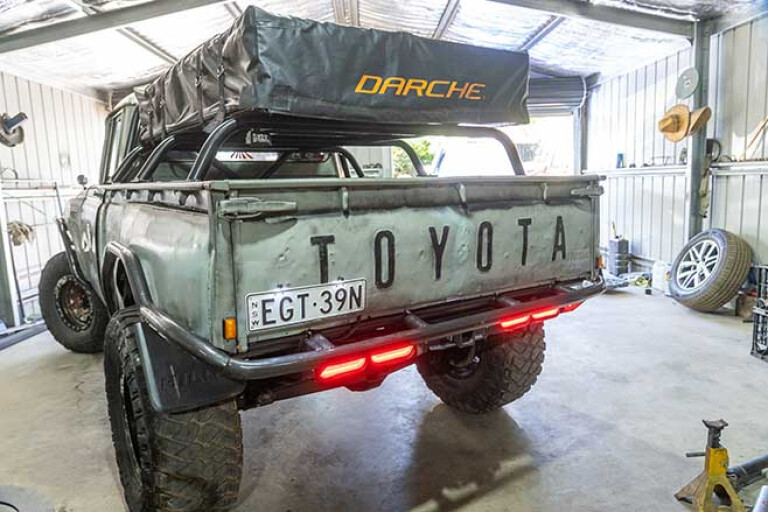
A FEW years back there was a bloke named Isaac Newton. He was mainly famous for having an apple fall on his head, but he also said something that’s just a little bit relevant to the rig you’re looking at right now: “If I have seen further, it is by standing on the shoulders of giants.”
The concept is pretty simple: the things we’re capable of are built on the foundations laid before, a constant march towards more knowledge, or in Taylor Shaw’s case, towards one of the most bad-arse 4x4s in the country.

If that name rings a bell it’s because this is the third 4x4 of Taylor’s we’ve featured in as many years, each one teaching him skills along the way. Before us is the culmination of that journey so far, a bad-to-the-bone 1969 Toyota Lite Stout that’s like nothing we’ve ever seen before.
Like all good project cars, this one started with more than a little wheeling and dealing, and a whole lot of sitting around. Taylor is just the third owner, his uncle before him, his uncle’s neighbour before that signing the paperwork brand-new for just a couple of grand 52 years ago. The price when Taylor took ownership? A ride-on lawn mower in a handshake swap.
80 SERIES SWAP
From there Taylor wheeled it into his shed, parked a petrol-powered 80 Series LandCruiser next to it, fired up the plasma cutter and proceeded to make one vehicle out of two. Taylor used the skills he’d learnt building his previous rigs to free both front and rear axles from the 80 Series chassis they were previously attached to, and graft their mounts on to the ’69 Stout frame.

To keep it looking factory, Taylor carefully unpicked the OEM spring seats and shock mounts from the 80 frame as well and transferred them to the Stout frame. While the welder was fired up, a thick-walled brace was added along the back edge of the rear axle, helping it cope with the added stresses of low-range rock bouncing at low tyre pressures.
An ARB air compressor was also given the nod, air lines running along the Stout’s chassis rails plugging into air lockers front and rear giving maximum traction at the flick of a switch. While the housings were stripped back to bare metal, he ran through them wheelnut to wheelnut replacing every bearing, seal, bushing and brake component, helping the Stout drive better than it ever has.
SUSPENSION
Front and rear the ’Yota is running three-inch lifted coil springs from EF; although, as the weight is completely different to what they’re rated for and the coil mounts are sitting wherever Taylor felt they fitted best – and there’s no real reference point for ‘lift’ in a rig like this – exactly how high it’s sitting over stock is anyone’s guess.

The shocks are another mix-and-match type affair, as Taylor is still fine-tuning the beast he’s thrown in a hodge-podge of shocks that were in the donor 80 Series, as well as a couple that were kicking around his shed.
WHEELS & TYRES
Moving farther out and things get a little more big-ticket. On each corner are a set of lightweight aluminium wheels from USA-based Dirty Life. Punching in at 17x9 the ‘Roadkill’ wheels are a beadlock design allowing Taylor to drop down to single-digit pressures for maximum traction, something necessary with the lightweight body sitting above them.
The beadlock ring not only holds the bead tight but also serves as a sacrificial component protecting the wheel itself from serious rock rash. Each wheel is wrapped in a Maxxis MT772 RAZR muddy, with Taylor’s punching in at 315/70R17.
POWERTRAIN
With serious off-road work to be done, and a lethargic carburetted four-cylinder sitting under the bonnet, the choice was pretty clear for Taylor. Out came the engine crane and the 1FZ-FE sitting in the donor 80 Series was liberated from its previous home and lined up inside the engine bay of the Stout.
The 212hp six-cylinder, double overhead cam, four-litre mill is a significant upgrade with more than twice the power of the old 80hp motor, but that also meant significant work was required to make it fit.

A custom alloy radiator up front mixed with thermo fans help save some space, while a tubed firewall at the back of the engine takes up the slack. Taylor pieced together an exhaust system to fit in the significantly smaller Stout that’s the same overall length as the original 80 Series system to keep noise down. It snakes around through two mufflers before punching out the side of the tub away from potential damage caused off-road.
The whole package is backed up by the standard five-speed cog-swapper and transfer case from the 80 Series, with the stock 80 driveshafts in place, too, as the wheelbase is the perfect match between the two vehicles.
BODY WORK
While the body looks largely stock from the outside, that’s testament more to the effort Taylor’s put in rather than luck. The paint up front is the same as it rolled off the production line 52 years ago, albeit with a few more dents and scrapes along the way. However, the tub is off a different vehicle and Taylor’s worked wizardry on the rattle cans to make the tub match the cab.

Eagle-eyed readers will spot black rattle can strips along the flanks where Taylor has sliced into the metal work and pumped it out a couple of inches either side, to help cover the wider track. The front end also copped bonnet pins; the alloy radiator sitting where the old bonnet latch sat; while the roof is the only part of the vehicle with neat paint, a lashing of white on the lid helping keep internal temperatures down.
BODY ARMOUR
Of course all that time and energy into the body couldn’t be thrown away at the first sight of a stray rock, so Taylor has heavily armoured up the lightweight rig from front to back. Up front, sitting tight to the body is a tube bar, housing the built Warn 8274 high-mount winch recessed back into the grille.
It flows rearwards into neat scrub rails over the front and rear wheels, linked by plate-steel rocker panels below the doors before finally tying into the rear tube bar. Taylor’s welder also pieced together the tub rack that holds the huge rooftop tent.

We can go on and on about the intricate details of Taylor’s latest wild ride, from the false floor in the tub to the sneaky air outlet hidden under the tie-down rails. The attention to detail in this build is insane and something that can only be appreciated in person.
For now though, the build is done, as done as can be, the lessons learnt, a new project in the pipeline, and some of the toughest tracks in the country about to come face-to-face with the toughest Stout in the country. One thing is for sure, though, if the Stout is any indication of just how far Taylor’s skills have grown in such a short time, there’s going to be some seriously insane builds rolling out of his shed in future.
BEADLOCKED WHEELS
IF you scratched your head a little at the comment about beadlocked wheels, fear not; they’re l something only one in 10,000 4WDs would run, but there is a reason they’re gaining popularity in the hardcore weekender crowd.
A GUIDE TO: Beadlock Wheels
In a typical arrangement, a tyre is held in place on the wheel by means of air pressure keeping a ‘bead’ or rib on the tyre’s edge pushed into a seat. Run too low a tyre pressure though, and that contact point weakens, allowing the wheel to spin inside the tyre, or the tyre to come off the wheel completely. Not something you’ll face driving to the local campsite, but if your wheels are bound up in the rocks and you’re in low range, it’s not uncommon.
A beadlock wheel fixes this issue by physically locking the tyre’s bead to the wheel. The locking ring sandwiching the tyre's bead against the wheel’s external grooved surface, and the bolts on the outer edge squeezing it in place. It is an extra service point on the vehicle to monitor, but means single-digit tyre pressures are completely safe off-road.

COMMENTS